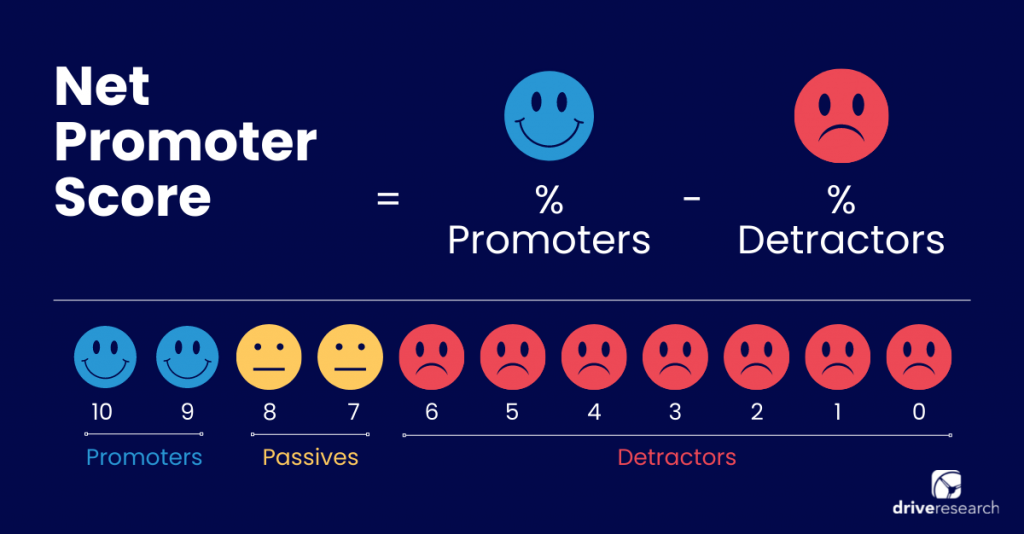
How likely are customers or members willing to recommend your financial institution?
It’s an extremely important question – but one that only a few banks or credit unions seek the answer to.
Net promoter score (NPS) is a powerful tool used by many brands across industries to measure customer satisfaction and identify their happy clients and the not-so-happy ones.
Undoubtedly, calculating NPS is beneficial for those in the financial sector as it quickly identifies areas that need improvement and better their services in the future. Keep reading as our customer satisfaction survey company discusses the importance of measuring net promoter scores and how to improve NPS for banks and credit unions.
How to Measure NPS for Banks or Credit Unions
In banking services, net promoter score has never been so critical. With the growing technology and more personalized banking services, you can’t afford to ignore the value of customer or member loyalty.
NPS measures your members’ experience (MX) depending on the answers to this question…
On a scale of 1 to 10, how likely are you to recommend [BANK ABC] to a friend, relative, or colleague?
The question is often included in surveys for banks and credit unions. Respondents give a rating between 0 to 10, where 0 means not at all likely and 10 means extremely likely.
Subject to their responses, customers fall into one of the following three categories that help to measure an NPS score:
- Promoters are loyal customers who are happy with the bank’s services. They respond with a score of 9 or 10.
- Passives are the ones who are just content with the financial institution’s services but are not pleased enough to refer someone. They respond with a score of 7 or 8.
- Detractors are unhappy customers or members. If you don’t give them attention, they’re not likely to buy from you again, and they may even discourage other interested customers. They respond with a score of 0 to 6.
To calculate the NPS of your bank, you just need to find the difference between the percentage of detractors and the percentage of promoters.
For instance, if 80% of your customers are promoters, 50% are passives, and 20% are detractors, the NPS score, in this case, is 60 (80-20).

Why Financial Institutions Should Measure NPS
According to Nielsen, 92% of consumers say they trust recommendations from friends and family, above all other forms of advertising.
Additionally, 23% of adults report using online reviews when choosing a bank or other financial services provider.
These figures speak volumes about the significance of calculating and improving NPS. Here are a few other reasons why.
Reason #1: To Measure Consumer Loyalty
Studies have proven that brand loyalty is on the rise. 59% of customers are willing to refer brands they like to their family and friends, and 66% admit to spending more on brands to which they are loyal to.
Therefore, measuring consumer loyalty with market research is a major reason why banks should ask customers how likely they are to recommend their institution.
As a result of calculating NPS, organizations can quantify member satisfaction and loyalty to help increase business.
Learn more about running a member survey at your credit union.
Reason #2: Gather Reasons for Dissatisfaction and Identify areas to Improve
The good thing about NPS surveys is that they measure both qualitative and quantitative data. Besides detecting detractors, passives, and promoters, NPS surveys also gather the reasons for customer dissatisfaction.
Our bank and credit union market research company always recommends adding a follow-up question after respondents provide their scores.
In an open-ended question, we ask “Please explain why you rate [Bank ABC] a [Insert Score].”
In doing so, you can easily collect customer feedback. It puts the why behind the what.
Additionally, you can use correlation analysis for a deeper understanding of customer satisfaction or dissatisfaction. Perhaps there is a correlation between home loan customers and strong dissatisfaction scores.
This insight gives you a clear path for what services require your attention more than others.
Reason #3: Align Business Plans with Customer Expectations
Measuring NPS will help you identify customers’ expectations in terms of improvements and features. For instance, when you ask a follow-up NPS question like ‘What can we do to make your experience better’ it encourages your customers to share their suggestions.
These suggestions will help you understand your customers’ expectations and align your business plans accordingly.
Reason #4: To Reduce Customer Churn Rate
For most businesses, churn rate refers to the number of customers who’ve left your company in a certain period due to a bad experience. When customers suddenly leave your company, how do you know the reasons for the exit?
When it comes to banking services, it’s all about numbers. So, you’ll need to keep track of the ongoing and incoming customers, and measuring NPS can help you with this.
How to Improve Your Bank’s NPS
What is common between a bank and say a tech company like Amazon? Both of them have access to a lot of customer information and data.
While Amazon uses this data to offer excellent customer service, banks are only now realizing that traditional approaches to customer experience are no longer effective.
Today, customers are more tech-savvy than ever, and they expect a better customer experience.
The average NPS score for the financial services sector is 34, but happy customers can take it all the way to 70.
So, how do you improve your bank’s NPS? Below are some of the actionable tips to consider:
- Involve everyone. If you have a low NPS, that’s an issue for everyone. Make sure the whole team at the bank is aware of NPS and why it is vital. Find better ways of communicating with prospects and make them happy about your business.
- Get promoters’ opinions. These customers already like you. It would help to learn where they get their sense of connection.
- Ask passives how you could better your services. It is easier for a passive respondent to become a promoter than it is to win over a detractor. Use their genuine criticisms as a basis for sincere reflection. You can use customer surveys for banks and credit unions to collect responses, reactions, and comments from them.
- Improve front-line communication. Build the human connection to show customers that you value their business. Make sure you have the right customer service reps who can offer personalized and efficient care.
- Leverage technology: As the future of banking technology is changing the way we manage our finances, customers expect fast personal online services. Therefore, banks need to adopt a more agile approach to keep up with the competition and improve how they interact with customers.
Measure Your Bank’s NPS with Drive Research
If you’re interested in working with a financial services market research company to measure your bank’s NPS and other key performance indicators, our team can help.
Drive Research specializes in many market research options for banks and credit unions including customer surveys, focus groups, UX, mystery shopping, closed account surveys, and more.
Contact us today for more information on our services.



